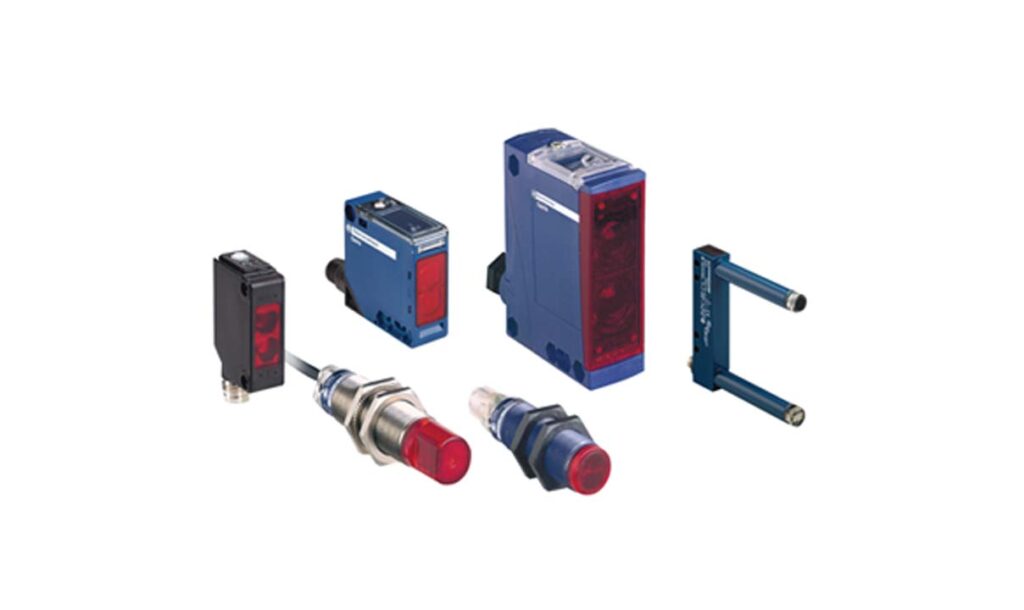Choosing the right photoelectric sensor for your specific application can be a game-changer in optimizing efficiency and performance in various industries. Telemecanique, a leading brand in automation and control, offers a wide range of photoelectric sensors designed to meet diverse needs. At Balaji Switchgears, we understand the importance of selecting the right sensor for your application, ensuring optimal performance and reliability.
Understanding Telemecanique Photoelectric Sensor Types
Telemecanique offers several types of photoelectric sensors, each with unique characteristics and advantages. Understanding these Telemecanique photoelectric sensor types is the first step toward making an informed choice.
1. Through-Beam Sensors
Through-beam sensors consist of a separate emitter and receiver. The emitter projects a beam of light towards the receiver, and the sensor detects the object when the beam is interrupted. These sensors are ideal for applications requiring long sensing distances and high accuracy.
- Advantages:
- High sensing range
- Excellent precision
- Reliable in dusty or dirty environments
- Applications:
- Object detection on conveyor belts
- Counting objects on a production line
2. Retro-Reflective Sensors
Retro-reflective sensors have an emitter and receiver housed in the same unit. They use a reflector to bounce the emitted light back to the receiver. These sensors are suitable for detecting transparent objects and offer moderate sensing ranges.
- Advantages:
- Easy alignment
- Effective for detecting reflective and transparent objects
- Applications:
- Bottle detection on a bottling line
- Presence detection in packaging machines
3. Diffuse Sensors
Diffuse sensors operate by detecting the light reflected directly off the target object. They are highly versatile and suitable for applications with shorter sensing distances and varying object colors or surfaces.
- Advantages:
- Simplified installation
- Suitable for applications with limited space
- Applications:
- Presence detection of items in a bin
- Color differentiation in sorting systems

Factors to Consider When Choosing a Telemecanique Photoelectric Sensor
When selecting the right Telemecanique photoelectric sensor types for your application, consider the following factors:
1. Sensing Distance
Determine the required sensing distance for your application. Through-beam sensors offer the longest range, while diffuse sensors are better for short-range applications.
2. Object Characteristics
Consider the size, shape, color, and reflectivity of the objects you need to detect. Retro-reflective sensors are excellent for transparent or reflective objects, while diffuse sensors are suitable for varied colors and surfaces.
3. Environmental Conditions
Evaluate the environmental conditions where the sensor will be used, such as temperature, humidity, dust, or dirt. Through-beam sensors are reliable in harsh conditions, whereas diffuse sensors may require more protection in dirty environments.
4. Response Time
For high-speed applications, the sensor’s response time is crucial. Ensure the chosen sensor can keep up with the speed of your operation to avoid errors in detection.
5. Installation Space
Assess the available space for sensor installation. Diffuse sensors are compact and suitable for tight spaces, while through-beam sensors may require more room for proper alignment.
Implementing Telemecanique Photoelectric Sensors with Balaji Switchgears
At Balaji Switchgears, we offer expert guidance and support to help you choose the right Telemecanique photoelectric sensor for your application. Our team can assist you in evaluating your specific needs, ensuring that the selected sensor type aligns with your operational requirements.
1. Expert Consultation
Our experienced professionals are available to consult on your project, offering insights into the best sensor type based on your application’s unique demands.
2. Customized Solutions
We understand that each industry and application has its challenges. Our team can provide customized solutions tailored to your specific needs, ensuring seamless integration and optimal performance.
3. Ongoing Support
Beyond selection and installation, Balaji Switchgears provides ongoing support and maintenance services to ensure your photoelectric sensors operate efficiently over the long term.
Conclusion
Choosing the right Telemecanique photoelectric sensor types for your application involves careful consideration of various factors, including sensing distance, object characteristics, environmental conditions, response time, and installation space. By understanding the differences among through-beam, retro-reflective, and diffuse sensors, you can make an informed decision that enhances your operational efficiency.
At Balaji Switchgears, we are committed to helping you find the ideal sensor solution for your needs. Contact us today to learn more about our range of Telemecanique photoelectric sensors and how we can assist in optimizing your application’s performance.
Originally Published at: https://balajiswitchgears.com/how-to-choose-the-right-telemecanique-photoelectric-sensor-for-your-application/
Comments
Post a Comment